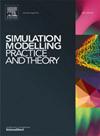Modeling and functional verification of autonomous emergency braking systems based on extended colored hybrid petri nets
IF 3.5
2区 计算机科学
Q2 COMPUTER SCIENCE, INTERDISCIPLINARY APPLICATIONS
引用次数: 0
Abstract
The autonomous emergency braking (AEB) system constitutes a critical safety function within advanced driver assistance systems (ADAS). Verifying its functionality is essential to ensure its operational correctness and reliability. Currently, AEB systems developed by different vendors employ diverse algorithms and lack a unified simulation, verification, and fault-detection framework. To bridge these gaps, this paper proposes a comprehensive modeling and functional verification framework for AEB systems. First, we establish a basic model using extended colored hybrid Petri nets (ECHPN). Next, we enhance this model by incorporating fault observation points to form an FD-ECHPN, thereby enabling fault detection and localization. Furthermore, this paper develops a universal simulation and testing approach to verify the functionality of AEB systems from various vendors by transforming the FD-ECHPN model into a Simulink/Stateflow model. The simulation results demonstrate that the proposed method can accurately assess the functionality of an AEB system and effectively identify and localize faults during model execution. Finally, we examine the state evolution and formal properties of the FD-ECHPN model to verify its correctness.
基于扩展彩色混合petri网的自主紧急制动系统建模与功能验证
自动紧急制动(AEB)系统是高级驾驶辅助系统(ADAS)中的一项关键安全功能。验证其功能是确保其操作正确性和可靠性的必要条件。目前,不同厂商开发的AEB系统采用不同的算法,缺乏统一的仿真、验证和故障检测框架。为了弥补这些差距,本文提出了一个全面的AEB系统建模和功能验证框架。首先,利用扩展的彩色混合Petri网(echnn)建立了一个基本模型。接下来,我们通过将故障观测点合并到FD-ECHPN中来增强该模型,从而实现故障检测和定位。此外,本文开发了一种通用的仿真和测试方法,通过将fd - ecpn模型转换为Simulink/Stateflow模型来验证来自不同供应商的AEB系统的功能。仿真结果表明,该方法能够准确地评估AEB系统的功能,有效地识别和定位模型执行过程中的故障。最后,我们检验了fd - echnn模型的状态演化和形式性质,以验证其正确性。
本文章由计算机程序翻译,如有差异,请以英文原文为准。
求助全文
约1分钟内获得全文
求助全文
来源期刊

Simulation Modelling Practice and Theory
工程技术-计算机:跨学科应用
CiteScore
9.80
自引率
4.80%
发文量
142
审稿时长
21 days
期刊介绍:
The journal Simulation Modelling Practice and Theory provides a forum for original, high-quality papers dealing with any aspect of systems simulation and modelling.
The journal aims at being a reference and a powerful tool to all those professionally active and/or interested in the methods and applications of simulation. Submitted papers will be peer reviewed and must significantly contribute to modelling and simulation in general or use modelling and simulation in application areas.
Paper submission is solicited on:
• theoretical aspects of modelling and simulation including formal modelling, model-checking, random number generators, sensitivity analysis, variance reduction techniques, experimental design, meta-modelling, methods and algorithms for validation and verification, selection and comparison procedures etc.;
• methodology and application of modelling and simulation in any area, including computer systems, networks, real-time and embedded systems, mobile and intelligent agents, manufacturing and transportation systems, management, engineering, biomedical engineering, economics, ecology and environment, education, transaction handling, etc.;
• simulation languages and environments including those, specific to distributed computing, grid computing, high performance computers or computer networks, etc.;
• distributed and real-time simulation, simulation interoperability;
• tools for high performance computing simulation, including dedicated architectures and parallel computing.
 求助内容:
求助内容: 应助结果提醒方式:
应助结果提醒方式:


